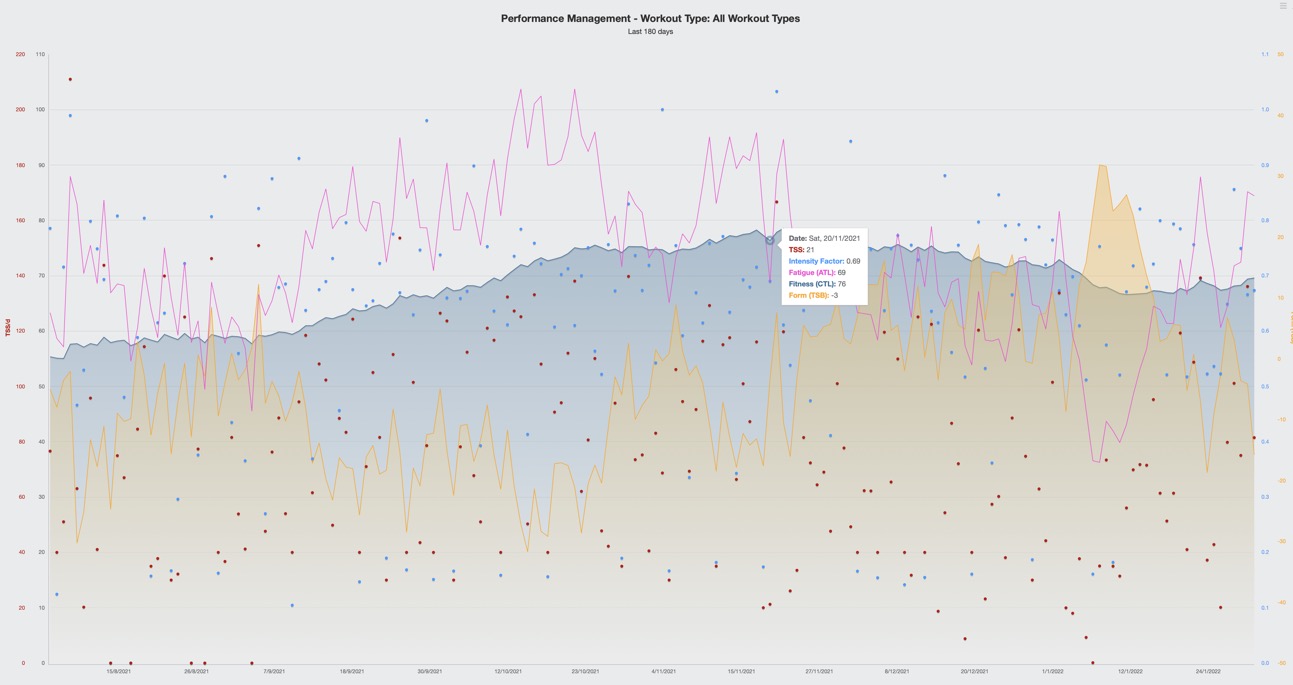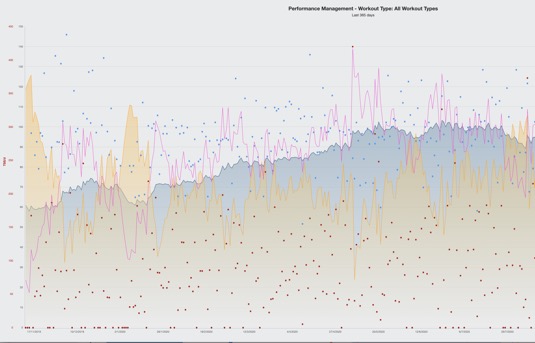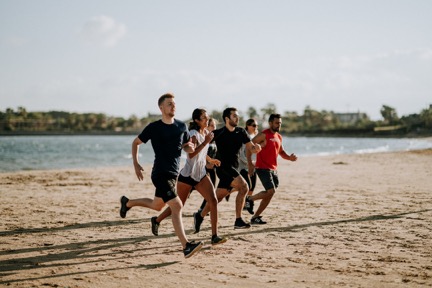
TrainingPeaks Explained
TrainingPeaks explained
TrainingPeaks has amazing metrics which can really help you keep track of progress and make sense of your workouts as you move through your training or general fitness routine.
Understanding some of the metrics it offers can help you make valuable decisions on how much stress you're creating, and how much rest you might need.
Understanding these things can help with optimising your time and workout strategy so you can be the best you in the time available in what can be a very hectic time crunched average week for a lot of people.
First off is understanding what the values within TP actually mean, TSS, IF, CTL, ATL, TSB. A little bit information overload until you see how simple those abbreviations can become.
Let me explain, for any given workout you will create values based on an algorithm built into TP software.
Coaches worldwide trust TP for the accuracy to ensure any athletes we coach are getting the best quantified measure for their hard work, so certainly what you see can be taken with a large degree of accuracy. (Apart from the human factor, which I'll explain later).
For example if you do a workout using a device which records data, HR, Power, GPS, and so on you will then be feeding information into TP which it uses to create your scores.
A 1 hour bike ride done at FTP, (functional threshold power) for the entirety will provide you with 100 TSS. Training stress score.
Think of this as a balance, think back to the old kitchen scales that balance out with equal weight either side. Your week starts with one side being at 500, if you keep both sides slightly above or below without the scales topping out then you're doing well.
Although there are times when that will go out of balance, injury or illness being one, and planned overload.
Over time you will have an average TSS per week, let's say its 500 TSS.
Each week your goal might be to keep those scales in balance by creating enough workload to keep hitting roughly 500 TSS per week. Perfect, consistency and general fitness remains at a very good level for those looking to maintain good health and balance.
The tricky part is knowing where that balance should be. If you're new to all of this, you might have a few weeks of data and feel great with a weekly total of 500 TSS, but over time by continuing to hit that balance you might either start feeling fatigued or feel like you're not getting any fitter. Progress has stopped.
The more data you accumulate over time the better your choices can be to stay in balance.
Now we can move to the other metrics,
CTL or fitness, (chronic training load).
CTL records a running tally of data over the past 42 days to create a number based on your daily average TSS.
CTL is a valuable metric for measuring progress, also as a means of looking at balance.
Due to most people having time restraints, once you progress upward with your CTL or fitness score, it can then become very difficult to keep driving that number upward. As an example someone who realistically has time to train 6-8 hours a week may struggle to go over 65 CTL, whereas a full time professional can sit in the 120 CTL region and still feel quite fresh. Remember longer duration will add more TSS points even when doing light exercise. A 5 hour bike ride done at 50% FTP is roughly 250 TSS , so a professional athlete will easily see weekly scores of 1200+ TSS. That weighted average will see them sit over 100 for CTL due to the time they have available to train.
What I like to do with CTL or fitness is compare year on year, or event to event.
If you look at your fitness score right now, is it higher or lower than this time last year? Or look at a previous event where you know you were at peak condition, we can then use that to aim for a similar scenario.
ATL or fatigue, Acute training load.
ATL is the fatigue built up based over the last seven days.
Again, you will notice patterns here. Usually weekends will drive this up as we generally workout longer creating more fatigue. This is fine as we do need some fatigue to make improvements, as long as we don't hold that fatigue up for long periods of time.
TSB Training stress balance or form
TSB is calculated by subtracting yesterdays fatigue from yesterday's fitness.
CTL Fitness - ATL Fatigue = TSB Form
TSB is very useful when tapering into an event. Generally a positive number represents you are rested and ready for your event. This can also mean you are over adapted or undertrained so this is an area to look for as well.
A neutral or near neutral TSB means you are adapted well to the current training.
A negative can mean you are not adapted to the load yet, or have been overloading your training. There are cases when this is a planned case when being coached.
My final one is IF, Intensity factor.
This is the percentage of your functional threshold power, or pace.
Let's say you do a workout and the average of that workout is done at 80% of Normalised power for cycling, Normalised graded pace for running NGP, or CSS critical swim speed for swimming. That gives you 0.80 IF. Time here isn't taken into the equation.
So if you do a 10 minute workout all at threshold then you will get 1.00 IF compared to doing a 5 hour workout which averages at threshold for the full duration, that will still be 1.00 IF.
So think of IF as how much oomph you've put into the session.
I did mention the human factor earlier.
This is where awareness and listening to your body comes in.
Numbers alone are one thing, but even with all the science and information available, it's still not an exact.
Feel is a great means of telling when to back off or when to up your game. If you feel tired for a string of days, then have that rest day even if the numbers don't show it.
The numbers use stress as a factor, well mental stress also accumulates, but this is not something any software can pull in for information.
Mental stress has the same effect as physical, so add a stressful week of work to a high TSS week and soon things can start feeling off.
Doing a self assessment is a good idea. As well as the data you accumulate in training per week, think about what else you've added to that.
Family, work, mood, yes even mood can all affect the balance. Make notes in your TP calendar, if you've had a stressful day, put it in. These are things you can look back on to build the picture as to why you may be tired or flip that around, feeling amazing.
Example of Performance management chart leading to a peak event

Keeping it Fresh
This time of year can sometimes feel like a lost or difficult time of year to transition your training.
I certainly get the same feeling, but years of experience has taught me how to work with this time of year, rather than let it get you down.
If you're someone who fears losing all the fitness you've gained through the year, it can be quite an anxious time. This can then be compounded if you use apps which show a fitness score such as TrainingPeaks.
We suddenly see that fitness score taking a nose dive and the self guilt can take over which can lead to a fairly miserable time mentally.
Well, fear not.
First we need to look at the fitness score and understand what its telling us. Different apps or software packages use different calculations, so I won't go into the full ins and outs as to how they all work.The basic is that they use equations using all your training data and come up with your score. Now that is an amazing tool to use both for coaches and athletes in order to see progression.
The thing to be comfortable with here is that those scores are a guide, they aren't an exact. If you work together with a coach, speak with them if you do get hung up on the data, and they will be able to explain where you are with it.
If you think about the progression you make through the winter into spring, then a lot of that work is structured to lift your fitness in a nice controlled manner, this is where working with your coach really comes in.
Now that progression takes structured sessions which build over a long period of time which generally also requires longer duration through your training period as well. Put all those pieces together and you see your fitness score gradually come up over a long spell of time, which is purposeful and again together with a coach is tailored to you.

So now your main goals may be finished for the year, and the next ones are quite a way in the distance, so of course we generally kick back a little. This is where some planing comes in and you can research your previous data.
If you look at your fitness score now and compare to this same time last year, how does it compare? Are you roughly the same, down a little or up a little or a lot?
If you're up on that last years number, happy days, if you're roughly the same, great. If that number is down, that's no problem, but you may need to look at how your progression is going to go from here forward.
No matter what, getting back to your desired level of fitness is achievable, but having patience is the key. The saying Rome wasn't built in a day springs to mind.
So let's look at this from another angle. If our fitness score stayed high all the time, how do we keep progressing?
Unless you're retired or a full time athlete most of us have to fit training around work, family, and other things going on in our lives. So what we tend to get is a top out point where we will hit a certain level and it then becomes extremely difficult to make big gains after that.
The key here is working with our available time and trying to hit that optimal level for your main events or goals. If we tried staying at that level year round, trust me, you will just end up fatigued and miss your mark all together for those main goals.
What we then need to do is throttle back a bit this time of year and look forward to that progression going on its upward cycle again. So really if you let yourself relax and recharge, you end up with an exciting prospect of seeing that fitness score creeping back up, which has a huge mental benefit.
Again, refer back to what I said before, look at where you are now compared to this time last year. What we don't really want to do is ease back so much that we drop off a cliff. We want just enough rest and recovery to give us a nice springboard to hit our first target in good shape. If that target is 3 months away for example, just how much can you let yourself ease back? If you're very experienced you may know that, if not, that can be difficult to know.
Mix it up
This is where the part comes in which is something I've always done in my training, it's not top secret or cutting edge, its actually quite simple.For me keeping the mind fresh is the biggest aspect for this time of year. If I carried on hammering my bike every day through wind, rain, or even sat on the turbo everyday, I know my mood wouldn't be great by the time I got to spring.
So I like to use a variety of other sports and keep things fresh, which also benefit neglected areas of our hunched over non extending bodies if you're a cyclist anyway.

Look at sports you enjoy, perhaps you came from another sport and would like to do some again through the winter. Go for it, you're going to meet old and new friends, no doubt there will be a social aspect to it with a different group of people, again great for the mind.
You may have a sport you'd like to try, why not give it a go, you may actually find the physical benefit will cross over to your main sport.
For me, I traditionally use running and weight training. Of course weight training is great to use year round, but we can now focus more on the strength aspect of it.
Running is a great workout for cardio which can take as little as 20 minutes. If its not your main sport, I'll guarantee you won't be efficient enough to find it easy, so it makes for a great threshold session without thinking about doing a threshold session.
Swimming as I'm now learning is a great workout, if you can swim gracefully, I'm very jealous, but again a brilliant alternative to just riding the bike.

Out of all of this, the main focus point is to keep the mind fresh. Do things you enjoy, and also new things that challenge you. When the hard work starts again, you'll be mentally rested and ready for it.
Welcome
WUP Welcome from Andrew Roche on Vimeo.
Apologies for the dodgy video, I never was any good in drama class.
Subscribe to be the first to get my latest updates and reviews, you will also receive a free one month sampler training plan as a thank you!
Coaching
Cycling
Event
Insoles
Ironman
Ladies
Marathon
Racing
Recovery
Reviews
Running
Skills
Sport
Tips
Training
Triathlon
